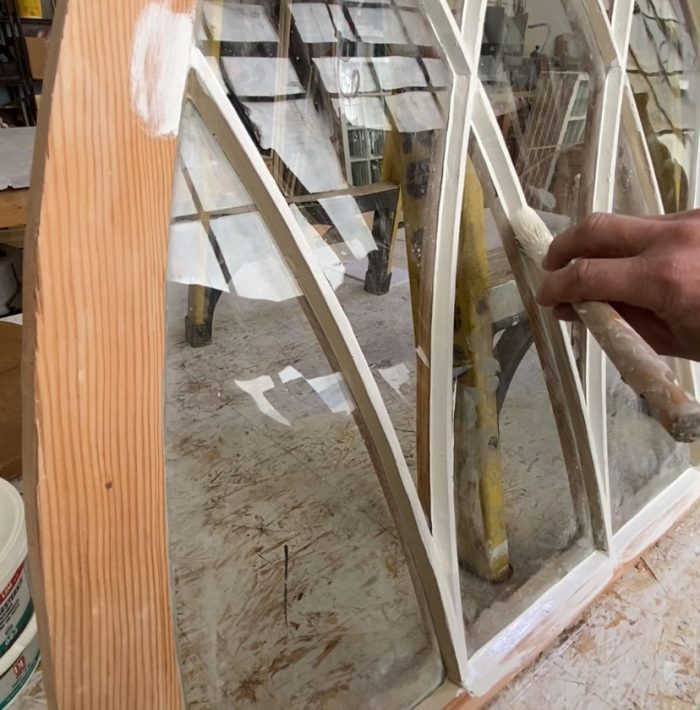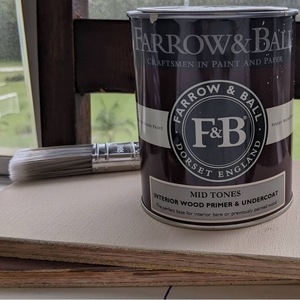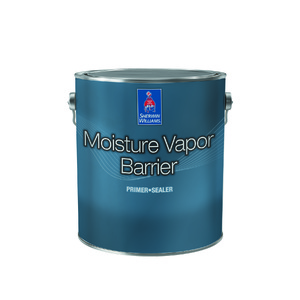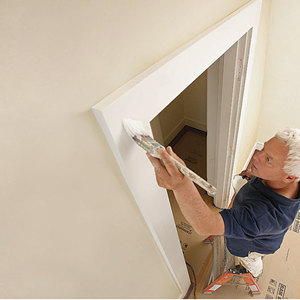
Most of my company’s work is focused on restoring or re-creating historic exterior elements—including windows, doors, and millwork—on houses between 80 and 250-plus years old. The houses we work on have some of the best old-growth lumber that this planet has ever produced; they have hundreds of growth rings per inch, are all or mostly heartwood, and have incredible dimensional stability. But after a century or more of service without maintenance or repair, the wood is beginning to fall apart.
So, what’s changed? There is a growing consensus among preservation professionals that our modern paints are to blame. For all the benefits of alkyd and acrylic exterior paints—and there are many, including affordability, flexibility, fast dry times, mildewcides, and more—there are some serious problems that nobody seems to be talking about.
Mode of failure
The penetrating nature of exterior oil-based paints makes them a popular choice, especially as a primer coat, but from an environmental and health perspective they have become a disaster. Nearly all modern oil-based paints have no oil in them at all; they are now called alkyds, which is another name for synthetic resin. Even if you’re willing to tolerate the nasty solvents, noxious fumes, and long list of petroleum-based chemical ingredients, you still may not be able to find a can. Alkyds have been banned in at least half a dozen states and restricted to quart-size cans in many others. I know fellow restorers here in Connecticut who drive to neighboring Massachusetts just to stock up on oil primer by the gallon. It may take some time, but it sure seems like the writing is on the wall: alkyds are not long for the U.S. market.
The strategy for success with modern exterior acrylic paints—which are, for all intents…
Weekly Newsletter
Get building science and energy efficiency advice, plus special offers, in your inbox.

This article is only available to GBA Prime Members
Sign up for a free trial and get instant access to this article as well as GBA’s complete library of premium articles and construction details.
Start Free TrialAlready a member? Log in














15 Comments
Fascinating? Epic? Excellent? I'm not sure which accolade is most appropriate but this is very interesting and seems like important information to know.
The more I practice, the more I try to avoid specifying any finishes that require maintenance or re-application in a few years - which limits my material palette considerably. But I've been reconsidering penetrating oil finishes more and more - particularly for interior wood finishes - and this article on linseed oil paints gives me more options for pigmented and exterior finishes (at my own home and on client projects). Thanks for this resource!
We finished our wood floors with Rubio Monocoat which is a linseed oil based product (only needs a single coat, thus the name). It's used in Europe more. We had to convince our floor installers that we wanted it. It looks fantastic though because you can really see the wood.
Ahh I posted about this for cabinetry… our supplier is really pushing their urethane coating but they also offer Rubio despite obviously not liking it very much.
I want a custom colour, apparently Rubio doesn’t like them to mix colours? I called BS politely and showed him the Rubio website where it clearly says you can mix colours for endless combos.
Apparently Rubio is also less durable and hard to maintain and clean? I get the sense that it would be fine on cabinets if so many people use it for flooring… my impression is that the cabinet company doesn’t like it because it can’t be sprayed on and it’s probably a bit harder to get a consistent result. Just curious how it’s held up on your floor? Have you had to maintain it somehow?
It's only a couple years old and we haven't bothered to do any maintenance on it. We have wool rugs on top in a lot of places and tile in our kitchen so less overall exposure for having wood floors in most of our house. We are meticulous about cleaning up and running the robot vacuum to keep it clean. Shoes are not allowed in our house as well. We probably should start doing some maintenance now in high traffic areas.
There's a fundamental advantage over traditional urethane: you can fix up individual spots. With a urethane coating you might need to redo an entire floor (or part of a cabinet) if you want it to look even. So it's actually easier to do maintenance with Rubio because you can maintain individual spots as needed. The downside is that yes it is less durable and there is a lot more maintenance to do in high traffic areas. With the urethane wood floors people do no maintenance on them for many years and then have them completely refinished. Refinishing floors is expensive and extremely disruptive though. From a long-term perspective it is not cost-effective and wasteful. But no maintenance required.
If it is workable on wood floors I can't imagine there being that much maintenance on cabinets if you keep them clean and are accessing them with clean hands. If they are close enough to the cooking to get grease splattered, etc then maybe that's the issue.
The way the final stain looks can be very different depending on the wood it is applied to. We used the walnut stain on red oak because on red oak it still comes out pretty light although it is strong enough to overcome the red. So you need to buy some samples and see them on the wood you are using. I would try to avoid mixing and stick with one of their standards if possible to make matching trivial in the future.
Thanks! Good point about touch up colour matching. Maybe we can use one of the existing colours then. I do like that it can be touched up, our current dining table has a clear coat on it which has gotten scratched from the cat using it as a launch pad. Fixing the fine scratches is really not possible due to the coating.
In my small design/build/restoration company, we've used linseed paints, oils, and pine tar finishes on both new and old, exterior and interior woodwork for more than ten years, and agree with the points made in the article. It absolutely works best over unfinished or stripped woodwork where it has the ability to soak in and bond. It does fade and chalk within a year or so, outside, where exposed to direct sun. It does not peel or flake. Knots will burn through, as they pretty much always do. The color can be revived with cleaning, fresh boiled oil, or a new coat of paint. There is a maintenance cycle - but I prefer reviving existing, sound woodwork rather than replacing it, even though I like carpentry more than painting. The attached photos show Ottosson linseed paint on a mix of spruce, eastern white pine, and cypress - all new woodwork first painted in 2012 and again in 2022 after considerable fading, but no rot. We repair rotted wood all the time that's been under latex and acrylic paint.,
The case for linseed paint sounds compelling. But the one year fading and chalking is tough. My house north of Boston shows 4 sides each with different effects on,what I assume to be mostly paint, but also stain. None of the cedar was coated on all 4 sides. Do you still do this? May I ask how your clients feel about the fading? The 10 year cycle you mentioned is beyond good. But the interim appearance may not appeal, especially at point of resale. Thank you.
I hate painting, try to avoid it whenever possible, but I really enjoyed your article. It was interesting, very informative, and fun to read.
Fifty-two bucks a quart? Does it spread itself?
The coverage for a quart of linseed paint is on par with a gallon of acrylic paint.
I'm getting ready to stain my cedar siding with Swedish pine tar paint by Auson mixed with linseed oil (bought from earth and flax in the US). I'm looking forward to using old ways on a new build.
Yes, the fading to a matte/flat look isn't everyone's thing. On our c. 1840 house and reproduction outbuilding, it looks fine to me. I'm willing to trade an even sheen for long term durability and not having rot everywhere. But, it's been a hard sell for clients who expect things to look shiny for more than a few years. You either have to maintain the sheen, or allow nature to turn it flat. I haven't used linseed paint for back-priming, but have used straight boiled oil - but we do always install siding on a lath strip rain screen, if new work. I have a lot more photos but need to figure out how to reduce them to less than 3 mb so they can be uploaded.
You should add Earth & Flax to the list of retailers.
They don’t make their own linseed paints and our list is limited to manufacturers/makers. That said, Earth and Flax is the sole distributor of Viking linseed paints, so they are listed under that name in our table. They also carry Ottoson and lots of other wonderful products…like Dana linseed putty!
Log in or become a member to post a comment.
Sign up Log in